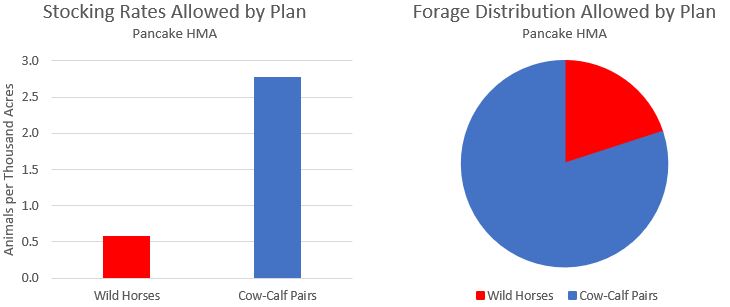The Pancake HMA, largest of the four areas in the Pancake Complex, covers 855,000 acres and has an AML of 493, according to Table 1 of the Draft EA for wild horse management actions therein.
The horses allowed by plan require 493 × 12 = 5,916 AUMs per year and the stocking rate allowed by plan is 493 ÷ 855,000 × 1,000 = 0.6 wild horses per thousand acres.
As noted earlier, fractional stocking rates may indicate large amounts of forage diverted to privately owned livestock.
The HMA intersects six allotments. Table 3 in the EA provides grazing seasons, livestock types and permitted AUMs. Although cattle and sheep are allowed in the area, the following calculations are based on cow/calf pairs only, for a direct comparison to wild horses. The resource requirements of cow/calf pairs and wild horses are said to be equivalent.
The map in Appendix I of the EA (page 78 in the pdf) does not show the allotment boundaries relative to those of the horse areas.
Table 3 does not provide the allotment sizes so those were sourced from the Allotment Master in the Rangeland Administration System. Five of them are administered by the Bristlecone Field Office and one is managed by the Mount Lewis Field Office.
A footnote in Table 3 says one of the Duckwater pastures has been closed to grazing since 2000 and that may explain why the permitted AUMs in the table are less than those in the RAS report. The impact on grazing land inside the HMA is not known, but the total calculated acreage exceeds the size of the HMA, suggesting that it’s 100% subject to permitted grazing.
A map like that in Appendix V of the Caliente EA (page 81 in the pdf) would be a nice addition to the Pancake EA, if you’d like to submit that as a comment.

The Duckwater permittees would have to place 1,556 cow/calf pairs inside the allotment to graze off 18,667 AUMs in twelve months (18,667 ÷ 12). The stocking rate would be 1.9 cow/calf pairs per thousand acres (1,556 ÷ 807,662 × 1,000).
The forage available to livestock on the Duckwater allotment inside the HMA is 1 × 18,667 = 18,667 AUMs per year. The forage available to livestock on the Six Mile allotment inside the HMA is .96 × 1,209 = 1,161 AUMs per year, assuming the resource is evenly distributed across the parcel.
The total estimated forage available to livestock inside the HMA is 23,662 AUMs per year.
The Six Mile permittee would have to place 97 cow/calf pairs inside the HMA to consume 1,161 AUMs in twelve months (1,161 ÷ 12). The total estimated number of cow/calf pairs inside the HMA is 2,371, with a weighted average grazing season of ten months per year (23,662 ÷ 2,371).
The estimated stocking rate allowed by plan inside the HMA is 2,371 ÷ 855,000 × 1,000 = 2.8 cow/calf pairs per thousand acres.
These figures are compared in the following charts.

The HMA—an area set aside for wild horses—is managed primarily for livestock. Cattle receive four times as much forage as the horses with a stocking rate that’s five times higher.
If the current population of horses, thought to be around 1,829 according to Table 1 in the EA, is destroying their habitat at a stocking rate of 2.1 animals per thousand acres, what do you suppose is happening when cattle are turned out a rate of 2.8 cow/calf pairs per thousand acres?
The forage assigned to livestock would support an additional 1,972 wild horses for a true AML of 2,465, which exceeds the current population by a comfortable margin.
There is no need for a roundup and no need for a fertility control program.
Unfortunately, those will be the primary enforcement methods until the management framework changes. The ranchers prefer roundups while the advocacy groups push for contraceptives. Nobody’s sticking up for the horses.
RELATED: Initial Thoughts on Pancake Gather Plan, Pancakes and Pie Charts!
